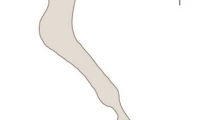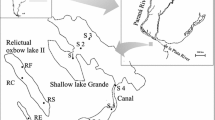Summary
-
1.
Spectrophotometric and paper chromatographic analyses have been made of pigments in the summer phytoplankton of eight lakes that widely differ in trophic characteristics.
-
2.
A comparison has been made between Margalef's pigment ratio, the carotenoid/chlorophyll-a ratio, the pigment diversity expressed as the number of coloured spots on a paper chromatogram, and the pigment diversity calculated by using the Shannon formula.
-
3.
No evidence has been found for an increase of diversity of phytoplankton pigments along a gradient from eutrophic towards oligotrophic lakes.
-
4.
Pigment diversity cannot be simply used as a measure of lake maturity according to Margalef's ideas.
Similar content being viewed by others
References
ANTIA, N. J., C. D. McALLISTER, T. R. PARSONS, K. STEPHENS and J. D. H. STRICKLAND, 1963. Further measurements of primary production using a large-volume plastic sphere. Limnol. Oceanogr. 8: 166–183.
BAUER, L., 1952. Trennung der Karotenoide und Chlorophylle mit Hilfe der Papierchromatografie. Naturwiss. 39: 88.
GEELEN, J. F. M., 1969. Vergelijkend planktononderzoek in twee Hatertse vennen. Ph. D. thesis, University of Nijmegen.
HALLEGRAEFF, G. M., 1976. Pigment diversity in freshwater phytoplankton. I. A comparison of spectrophotometric and paper chromatographic methods. Int. Revue ges. Hydrobiol. 61 (2): 149–168.
HALLEGRAEFF, G. M. in press. Pigment diversity in freshwater phytoplankton. II. Summer-succession in three Dutch lakes with different trophic characteristics. Int. Revue ges. Hydrobiol.
HALLEGRAEFF, G. M., R. LINGEMAN and B. J. G. FLIK, 1976. Physical characteristics, phytoplankton standing crop and primary productivity at the end of summer in four French crater-lakes. Ann. Stn. Biol. Besseen-Chandesse (in press).
HAXO, F. T., 1960. The wavelength dependence of photosynthesis and the role of accessory pigments. In M. B. Allen (ed.), Symposium on comparative biology. Vol. I. Comparative biochemistry of photo-reactive systems, p. 339–360. New York: Academic Press.
HEALY, F. P., J. COMBS and B. E. VOLCANI, 1967. Changes in pigment content of the diatomNavicula pelliculosa (Bréb.) Hilse in silicon-starvation synchrony. Arch. Mikrobiol. 59: 131–142.
JEFFREY, S. W., 1974. Profiles of photosynthetic pigments in the ocean using thin-layer chromatography. Mar. Biol., 26: 101–110.
MARGALEF, R., 1960. Valeur indicatrice de la composition des pigments du phytoplankton sur la productivité, composition taxonomique et propriétés dynamiques de populations. Rapp. Proc.-verb. C.I.E.S. M.M. 15: 277–281.
MARGALEF, R., 1961. Correlations entre certain caractères synthétiques des populations de phytoplankton. Hydrobiologia 18: 155–164.
MARGALFF, R., 1963. Modelos simplificados del ambiente marino para el estudio de la sucesión y distribución del fitoplancton y del valor indicador de sus pigmentos. Inv. Pesq., 23: 11–52.
MARGALEF, R., 1964. Correspondance between the classic types of lakes and the structural and dynamic properties of their populations. Verh. int. Verein. Limnol., 15: 169–175.
MARGALEF, R., 1968. Perspectives in ecological theory. University of Chicago Press. 111 p.
MOSS, B., 1973. Diversity in fresh-water phytoplankton. Am. Midl. Nat. 90 (2): 341–355.
ODUM, E. P., 1969. The strategy of ecosystem development. Science 164: 262–270.
PERSOONE, G., P. SORGELOOS, C. GROLIÉRE and N. OMALY, 1968. Sur la limnologie de quelques lacs du Puy-de-Dôme: physico-chimie et plancton de surface. Ann. Stat. Biol. Besse-en-Chandesse 3: 43–114.
SANGER, J. E. and E. GORHAM, 1970. The diversity of pigments in lake sediments and its ecological significance. Limnol. Oceanogr. 15 (1): 59–69.
TRAVERS, M., 1971. Diversité du microplancton du Golfe de Marseille en 1964. Mar. Biol., 8: 308–343.
VINCE, S., and I. VALIELA, 1973. The effects of ammonium and phosphate enrichments on chlorophyll-a, pigment ratio and species composition of phytoplankton in Vineyard Sound. Mar. Biol., 19 (1): 69–74.
WINNER, R. W., 1969. Seasonal changes in biotic diversity and in Margalef's pigment ratio in a small pond. Verh. Int. Verein. Limnol., 17: 503–510.
WINNER, R. W., 1972. An evaluation of certain indices of eutrophy and maturity in lakes. Hydrobiologia 40 (2): 223–245.
Author information
Authors and Affiliations
Rights and permissions
About this article
Cite this article
Hallegraeff, G.M. Pigment diversity in fresh-water phytoplankton. III. Summer phytoplankton of eight lakes with widely different trophic characteristics. Hydrobiological Bulletin 10, 87–95 (1976). https://doi.org/10.1007/BF02282215
Issue Date:
DOI: https://doi.org/10.1007/BF02282215




